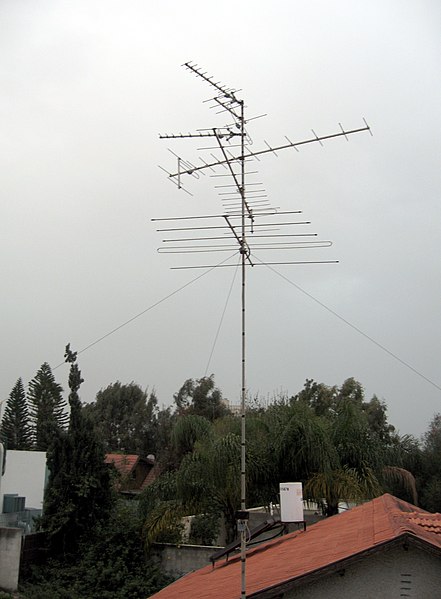A television antenna is an antenna specifically designed for use with a television receiver (TV) to receive over-the-air broadcast television signals from a television station. Television reception is dependent upon the antenna as well as the transmitter. Terrestrial television is broadcast on frequencies from about 47 to 250 MHz in the very high frequency (VHF) band, and 470 to 960 MHz in the ultra high frequency (UHF) band in different countries. Television antennas are manufactured in two different types: "indoor" antennas, to be located on top of or next to the television set, and "outdoor" antennas, mounted on a mast on top of the owner's house. They can also be mounted in a loft or attic, where the dry conditions and increased elevation are advantageous for reception and antenna longevity. Outdoor antennas are more expensive and difficult to install but are necessary for adequate reception in fringe areas far from television stations. The most common types of indoor antennas are the dipole and loop antennas, and for outdoor antennas the Yagi, log periodic, and for UHF channels the multi-bay reflective array antenna.

A Winegard 68 element VHF/UHF aerial antenna. This common multi-band antenna type uses a UHF Yagi at the front and a VHF log-periodic at the back coupled together.
Very common "rabbit ears" indoor antenna. This model also has a loop antenna for UHF reception.
A UHF television antenna
A rabbit ear indoor antenna weatherproofed and installed outdoors
Terrestrial television or over-the-air television (OTA) is a type of television broadcasting in which the content is transmitted via radio waves from the terrestrial (Earth-based) transmitter of a TV station to a TV receiver having an antenna. The term terrestrial is more common in Europe and Latin America, while in Canada and the United States it is called over-the-air or simply broadcast. This type of TV broadcast is distinguished from newer technologies, such as satellite television, in which the signal is transmitted to the receiver from an overhead satellite; cable television, in which the signal is carried to the receiver through a cable; and Internet Protocol television, in which the signal is received over an Internet stream or on a network utilizing the Internet Protocol. Terrestrial television stations broadcast on television channels with frequencies between about 52 and 600 MHz in the VHF and UHF bands. Since radio waves in these bands travel by line of sight, reception is generally limited by the visual horizon to distances of 64–97 kilometres (40–60 mi), although under better conditions and with tropospheric ducting, signals can sometimes be received hundreds of kilometers distant.

Indoor "rabbit ears" antenna often used for terrestrial television reception. This model also has a loop antenna for UHF reception.
Rooftop television antennas like these are required to receive terrestrial television in fringe reception areas far from the television station.





